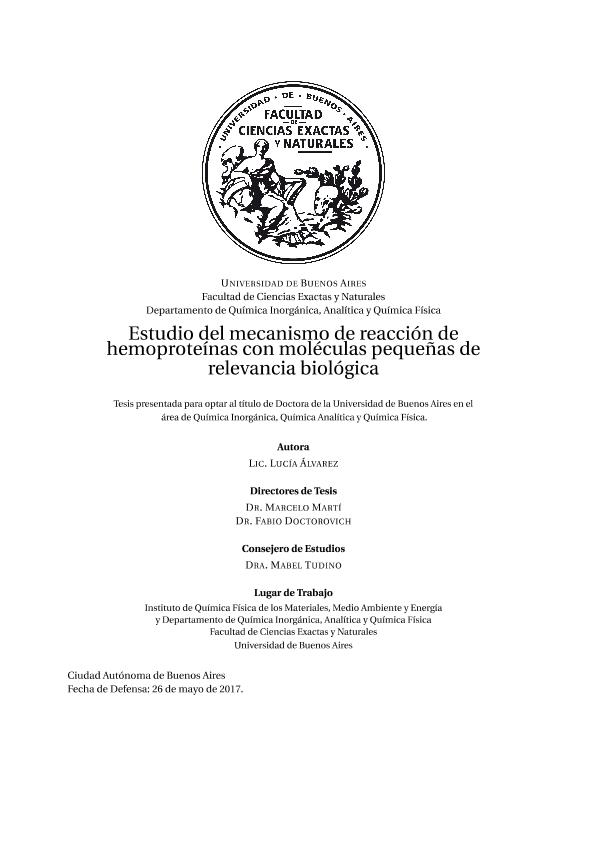Mostrar el registro sencillo del ítem
dc.contributor
Marti, Marcelo Adrian

dc.contributor
Doctorovich, Fabio

dc.contributor
Tudino, Mabel Beatriz

dc.contributor.author
Álvarez, Lucía

dc.date.available
2019-09-12T18:47:30Z
dc.date.issued
2017-01-01
dc.identifier.citation
Álvarez, Lucía; Marti, Marcelo Adrian; Doctorovich, Fabio; Tudino, Mabel Beatriz; Estudio del mecanismo de reacción de hemoproteínas con moléculas pequeñas de relevancia biológica; 1-1-2017
dc.identifier.uri
http://hdl.handle.net/11336/83439
dc.description.abstract
Las hemoproteínas son un conjunto ubicuo y extenso de proteínas, con una enorme diversidadfuncional relacionada con la versátil reactividad del ion de hierro del grupo hemo. La gran mayoría desus funciones biológicas involucran la unión de ligandos pequeños al metal, regulada por la identidad ydinámica de los aminoácidos de su entorno. La presente tesis tiene como objetivo aportar informaciónmicroscópica acerca de los mecanismos de reacción de distintas hemoproteínas con moléculaspequeñas de relevancia biológica, como ser O2, H2 O2, NH2OH e hidropersulfuros, utilizando unacombinación de técnicas de simulación computacional y experimentales, que incluyen, por unlado, dinámica molecular clásica (que abarca técnicas de muestreo demúltiples réplicas) e híbridascuántico-clásicas (para el estudio de fenómenos reactivos), y por otro espectroscopía UV-visible,cinética de reacción utilizando un equipo flujo detenido y un electrodo sensible a HNO, recientementedesarrollado por el grupo donde fue realizada la presente tesis, para el seguimiento de su producción.En primer lugar fue estudiada ?por técnicas de simulación?la unión de sustrato y el mecanismode reacción de dos dioxigenasas hémicas, la indolamino 2,3-dioxigenasa y triptófano 2,3-dioxigenasa,mostrando cómo la dinámica de un loop flexible modula la actividad enzimática al regular la entrada/salida de sustrato. En segundo lugar, se estudió la producción de HNO debido a la peroxidación dehidroxilamina catalizada por mioglobina. Se utilizaron técnicas experimentales para caracterizar la cinética de reacción, y luego se analizó el mecanismo de reacción a través de métodos computacionales.Por último, se estudió experimentalmente la reacción de hidropersulfuros con mioglobina,mostrandola capacidad de los mismos de regular la reactividad del grupo hemo.
dc.description.abstract
The hemeproteins comprise a large group of ubiquitous proteins with a great functional diversity related to the versatile reactivity of the iron atom in the heme group. Most of their biological functions involve small ligands binding to the metal atom, regulated by the identity and the dynamics of the aminoacids present in the active site. The main goal of this work is to give microscopic information about the mechanism of reaction of different heme proteins with small molecules of biological relevance such as O2, H2 O2, NH2OH, and hydropersulfides. The employed methodologies consist of both computer simulations and experimental techniques. On one hand classical molecular dynamics simulations were performed, in order to characterize flexible loop dynamics together with hybrid quantum mechanics-molecular mechanics (QM-MM) simulations that allow the analysis of reactive processes inside the protein matrix. On the other hand, experimental methods such as UV-vis were used to characterize the reaction products, and stopped-flow UV-Vis spectrophotometry to describe the reaction kinetics along with an HNO electrode to measure the HNO generation. Firstly, we studied, using computational techniques, the substrate binding and the reaction mechanism of two hemedioxygenases, tryptophan dioxygenase (TDO) and indoleamine 2,3 dioxygenase (IDO), showing how a flexible loop modulates the enzymatic activity of the protein by regulating the substrate and product entrance. Secondly, we studied the peroxidation activity of hydroxylamine catalyzed by myoglobin producing HNO. This was studied combining both experimental and computational techniques. Finally, we studied the reaction of hydropersulfides with myoglobin showing the capacity of regulation of the heme proteins by this type of compound.
dc.format
application/pdf
dc.language.iso
spa
dc.rights
info:eu-repo/semantics/openAccess
dc.rights.uri
https://creativecommons.org/licenses/by-nc-sa/2.5/ar/
dc.subject
Hemoproteínas
dc.subject
Mecanismo
dc.subject
Reactividad
dc.subject
Oxígeno
dc.subject
Hidropersulfuros
dc.subject
Hno
dc.subject.classification
Química Inorgánica y Nuclear

dc.subject.classification
Ciencias Químicas

dc.subject.classification
CIENCIAS NATURALES Y EXACTAS

dc.title
Estudio del mecanismo de reacción de hemoproteínas con moléculas pequeñas de relevancia biológica
dc.title
Study of the reaction mechanism of heme proteins with small molecules with biological relevance
dc.type
info:eu-repo/semantics/doctoralThesis
dc.type
info:eu-repo/semantics/publishedVersion
dc.type
info:ar-repo/semantics/tesis doctoral
dc.date.updated
2019-09-09T15:45:19Z
dc.description.fil
Fil: Álvarez, Lucía. Consejo Nacional de Investigaciones Científicas y Técnicas. Oficina de Coordinación Administrativa Ciudad Universitaria. Instituto de Química, Física de los Materiales, Medioambiente y Energía. Universidad de Buenos Aires. Facultad de Ciencias Exactas y Naturales. Instituto de Química, Física de los Materiales, Medioambiente y Energía; Argentina
dc.conicet.grado
Universitario de posgrado/doctorado

dc.conicet.titulo
Doctora en Química Inorgánica, Química Analítica y Química Física
dc.conicet.rol
Autor

dc.conicet.rol
Director

dc.conicet.rol
Codirector

dc.conicet.rol
Consejero de estudios

dc.conicet.otorgante
Universidad de Buenos Aires. Facultad de Ciencias Exactas y Naturales

Archivos asociados
